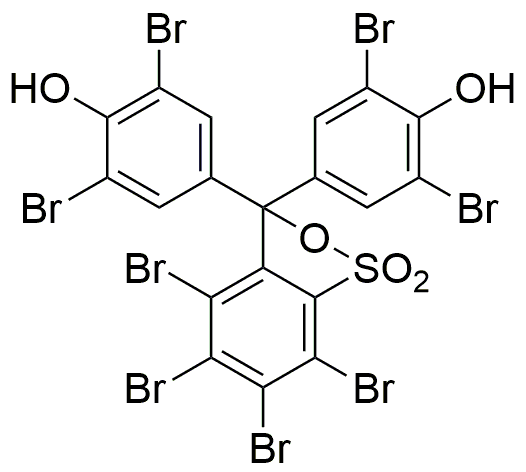Tetrabromophenol blue is widely utilized in research focused on:
- pH Indicator: This compound serves as a reliable pH indicator in various laboratory settings, particularly in titrations. Its distinct color change at specific pH levels allows researchers to easily determine acidity or alkalinity in solutions.
- Biochemical Assays: It is commonly used in biochemical assays to monitor enzyme activities and other biochemical reactions, providing researchers with essential data on reaction progress and efficiency.
- Staining Agent: In histology and microbiology, it acts as a staining agent, helping to visualize cellular structures under a microscope. This application is crucial for diagnostics and research in medical laboratories.
- Environmental Testing: Tetrabromophenol blue is applied in environmental testing to detect and quantify pollutants in water samples, aiding in the assessment of water quality and safety.
- Textile Industry: It is also used in the textile industry for dyeing processes, where its properties help achieve vibrant colors while ensuring the stability of the dye under various conditions.
General Information
Properties
Safety and Regulations
Applications
Tetrabromophenol blue is widely utilized in research focused on:
- pH Indicator: This compound serves as a reliable pH indicator in various laboratory settings, particularly in titrations. Its distinct color change at specific pH levels allows researchers to easily determine acidity or alkalinity in solutions.
- Biochemical Assays: It is commonly used in biochemical assays to monitor enzyme activities and other biochemical reactions, providing researchers with essential data on reaction progress and efficiency.
- Staining Agent: In histology and microbiology, it acts as a staining agent, helping to visualize cellular structures under a microscope. This application is crucial for diagnostics and research in medical laboratories.
- Environmental Testing: Tetrabromophenol blue is applied in environmental testing to detect and quantify pollutants in water samples, aiding in the assessment of water quality and safety.
- Textile Industry: It is also used in the textile industry for dyeing processes, where its properties help achieve vibrant colors while ensuring the stability of the dye under various conditions.
Documents
Safety Data Sheets (SDS)
The SDS provides comprehensive safety information on handling, storage, and disposal of the product.
Product Specification (PS)
The PS provides a comprehensive breakdown of the product’s properties, including chemical composition, physical state, purity, and storage requirements. It also details acceptable quality ranges and the product's intended applications.
Certificates of Analysis (COA)
Search for Certificates of Analysis (COA) by entering the products Lot Number. Lot and Batch Numbers can be found on a product’s label following the words ‘Lot’ or ‘Batch’.
*Catalog Number
*Lot Number
Certificates Of Origin (COO)
This COO confirms the country where the product was manufactured, and also details the materials and components used in it and whether it is derived from natural, synthetic, or other specific sources. This certificate may be required for customs, trade, and regulatory compliance.
*Catalog Number
*Lot Number
Safety Data Sheets (SDS)
The SDS provides comprehensive safety information on handling, storage, and disposal of the product.
DownloadProduct Specification (PS)
The PS provides a comprehensive breakdown of the product’s properties, including chemical composition, physical state, purity, and storage requirements. It also details acceptable quality ranges and the product's intended applications.
DownloadCertificates of Analysis (COA)
Search for Certificates of Analysis (COA) by entering the products Lot Number. Lot and Batch Numbers can be found on a product’s label following the words ‘Lot’ or ‘Batch’.
*Catalog Number
*Lot Number
Certificates Of Origin (COO)
This COO confirms the country where the product was manufactured, and also details the materials and components used in it and whether it is derived from natural, synthetic, or other specific sources. This certificate may be required for customs, trade, and regulatory compliance.


